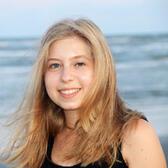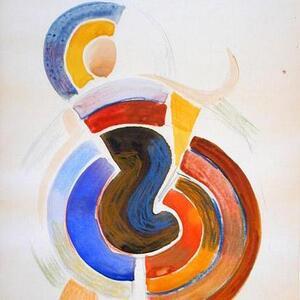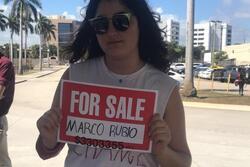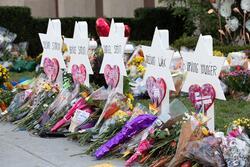Each Time I Enter the Synagogue: A Teen on Antisemitic Gun Violence
Each time I enter the synagogue, I scan the room, the furniture, and the exits. I evaluate who would be in danger if the shooting were to happen right here and right now, in this room versus the next. Though the shooter’s discretion obviously precludes my choice in the matter, the exact place of death remains unknown but vital, symbolically as well as logistically: How could I run, duck, throw my body over the child beside me if the bullets rained in the sanctuary versus the hallway, the classroom versus the art gallery? And where should I like to die: In the place of learning or prayer, the place of story or art?
I ponder these questions and fixations whenever I venture into a Jewish space. They exemplify the modern experience, not of a “Jew,” but of a progressive, Jewish, female-identified eighteen-year-old Hebrew school teacher’s assistant living in Texas. It’s an intersectional Jewish story of a reaction to antisemitic gun violence. It’s a Jewish story of someone whose identity cannot fit in the span of the three letters “J-E-W” alone. And, for this reason, it’s a Jewish story often untold in the news articles chronicling the aftermath of antisemitic hate crimes or in the Rabbi’s sermon on the steps of the bimah during worship and social gatherings for holidays.
Instead, the media and congregations circulate the presumed universal Jewish story of antisemitic gun violence: the story of the older rabbi; the story of a white man. In the New York Times, congregational rabbis and directors mourn for their lost congregants after a devastating synagogue shooting. In the Washington Post and NPR, synagogue leaders, elderly Shabbat goers, and presidents of major Jewish organizations lament the rampant uptick in hate crimes and antisemitic political rhetoric. These leaders give testimonies that they “stood…still in shock over the brutal massacre,” that “the United States is supposed to be a place of refuge,” that synagogue shootings are “frightening” for congregations still spared from gunfire because this “could happen anywhere at any time.”
At my own synagogue, older white clergy or Anti-Defamation League (ADL) staff deliver sermons critiquing these trends and lead educational programming that break down antisemitism, using much of the same language as the Jews in the news. These leaders share their Jewish story—one of surprise and fearful devastation—time and time again. Their Jewish story feels different from my own, which is a story not of fear, but of alertness to a threat far more normalized for me—a skeptical young woman growing up in the Trumpian era of xenophobia and violence—than for my elders, seemingly still faithful to the privileged, establishment conviction that “America will save the Jews.”
Nevertheless, these leaders speak for “The Jews,” apparently, expressing a frustratingly monolithic Jewish perspective on issues as vast as systemic oppression, online victimization, and hate crimes. They’re nearly all men, nearly all older, nearly all white—and both the media and the leadership of synagogues and Jewish institutions reach out to listen to their perspective, encouraging them to dominate the conversation around antisemitism and uniformly portray the gamut of Jewish experiences and sentiments. I understand why the media and synagogue leadership behaves as it does; it’s instinctual, for both the outsider and the insider, to assume Jews suffer one shared relationship with our oppression and its modern manifestations. But, unnerving and humbling as it is to recognize, we don’t. The undesirable truth is that these figures, even while resisting their Jewish oppression, perpetuate the marginalization of Jews with intersectional identities and stories unseen at the forefront of the conversation. Naturally, we look to leaders for answers. When we do, we forget that hearing only those in power deafens the Jewish community and American media consumers to non-mainstream Jewish voices. It silences their stories.
I shared my Jewish story with you: a story of my inescapable obsession with the death of children; an obsession that traps my teenage self in the liminal space between the child victim and the adult protector; an obsession reflective of the yearning for control against an indomitable threat. And though my young female story merits increased representation, it’s still a white story, uplifted by privilege. The perspectives of Jews of Color are too often made invisible to white Jews and erased from the conversation surrounding antisemitism.
Take, for example, experiences within my own synagogue. Recently, a white, middle-aged woman from the ADL presented to the seventh grade class for which I am a teaching assistant (TA) about antisemitism. The following week, when our class reflected on the session, the students, particularly the non-white students, criticized the ADL’s lesson. They critiqued the idea that students should respond to antisemitism from classmates in school with moral superiority and assertive explanations of the painful implications of these comments and stereotypes. A few white students casually vowed to punch the transgressor classmate, and our class teachers, who attended a similar ADL session for parents, jovially remarked that an adult had also said he would likely hit the antisemite. My co-TA, who is Latina (and has repeatedly had to navigate situations where classmates targeted her with antisemitic jokes and drew swastikas on her books), commented to me that, for her, anger and resistance only gives fuel to the offending classmates and increases her personal risk. Black and Latinx students face disciplinary action at disproportionate rates, so an explosive response to antisemitism is too dangerous to attempt.
Later, in a meeting with the cadre of TAs in our synagogue’s program, our white director instructed us to rely on the security and police around us in any situation that appears to jeopardize our safety. I lamented the alienating whiteness of such a statement—that our band of Jewish teens should place faith in synagogue police who may create an environment of fear for Black children in the religious school.
The Jewish community and the mainstream media must amplify these underrepresented stories as frequently and broadly as the common story of antisemitism shared by older white men. The weight of these intersectional Jewish stories measures the gravity of modern antisemitism in ways that the standard white metric cannot. We must destroy the monolith, even as the crumbling image of Jewish unity reveals a community whose members are sometimes at odds with one another in our perception of antisemitism and how to combat it.
This piece was written as part of JWA’s Rising Voices Fellowship.






